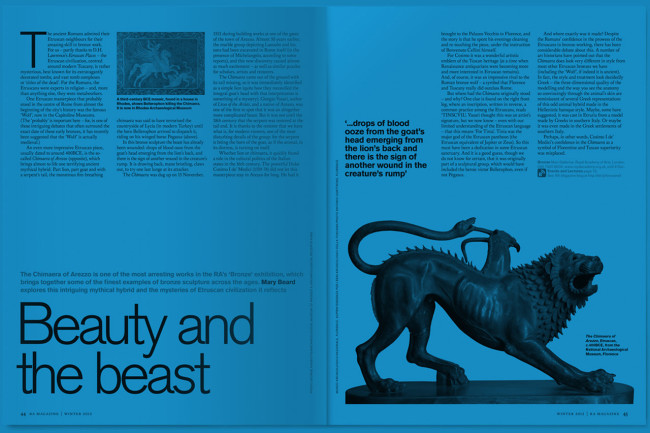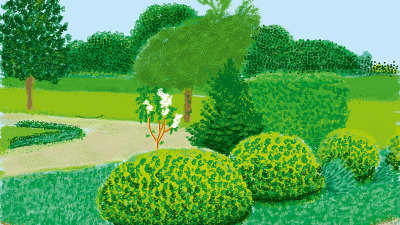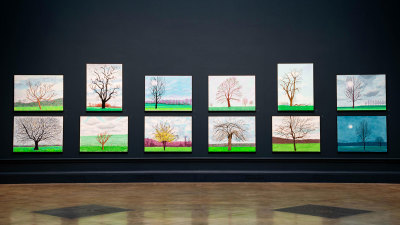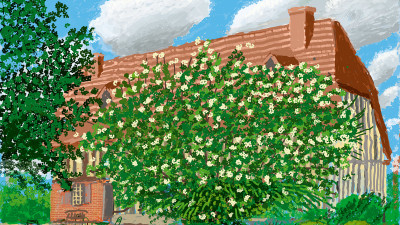Hockney: “People like pictures – they won’t go away”
By David Hockney RA and Martin Gayford
Published 27 September 2016
In an extract from their forthcoming book, A History of Pictures, David Hockney RA and Martin Gayford discuss the impact of the digital age on art. Will painting survive?
-
David Hockney The dial telephone dates my painting Mr and Mrs Clark and Percy [below], doesn’t it? Phones date fast, but I don’t think the picture itself has dated. Mr and Mrs Clark and Percy is a memorable picture; I realise that now, all these years later. But I’m not sure why.
Martin Gayford Pictures can be unforgettable, while depicting nothing out of the ordinary. Two people in a room, a view out of the window, a pet: those are the ingredients of Mr and Mrs Clark and Percy, and also of Van Eyck’s Arnolfini Portrait, painted over four-and-a-half centuries before. Some pictures prove to be perennial; they always appeal to us even if the objects in them become unfamiliar. In time, the exact significance of that white dial telephone, rather smart and stylish in 1971, will be remembered only by social historians (just as is true to today of Giovanni Arnolfini’s strange hat or his wife’s green gown). Perhaps gallery-goers of the future will wonder what on earth the white phone was, but they’ll probably still be looking with pleasure and interest at Celia Birtwell and Ossie Clark, the flowers and Percy the cat – just as we look at the animals painted on the walls of the cave at Lascaux, without knowing who depicted them or why they did so. Conversely, no-one in 1971 could have guessed that the humble phone would bring about a revolution in visual communication.
DH In the 21st century phones have become completely amazing. We’ve moved into a new era, and it’s because of what I’ve got in my pocket. Moreover, the changes are greatly about pictures. Once Hollywood alone had the money to use film technology, but now the technology is everywhere; everyone is becoming a bit of a film-maker because they have a video camera on their phone.
-
David Hockney RA and Martin Gayford in conversation
-
MG We are living through a revolution as profound as that brought about by printing in the 15th century, photography in the 19th and moving pictures in the 20th. Within the last decade, technology has appeared that makes it possible for enormous numbers of people to take a picture – still or moving – and almost immediately publish it to the world, or at least to their followers and contacts on Twitter, Instagram, WhatsApp and Snapchat.
The addition of a selfie button to smart phones has transformed the form of pictures just as the appearance of the box Brownie did in the late 19th century. Now 30 per cent of images sent by younger users of social media are selfies – meaning hundreds of millions of them are taken and sent each day. In a way, the effect is similar to that of the Claude glass on its owners in the 18th century. You start to see your surroundings in terms of a certain kind of picture: in this case, yourself posing with a significant companion or backdrop – beside George Clooney, in front of the Mona Lisa.
DH There’s a corollary to Andy Warhol’s idea that in the future everybody would be famous for fifteen minutes. Now, I think in the future nobody will be famous, only known locally to their friends and followers, because of the fragmentation of mass media.
The world today is full of images, but they aren’t very memorable, most of them. The more photographs you take, the less time you’ll spend looking at each one. At one time, there were only a few pictures around, now there are ever-increasing billions each year. What happens to them all? How will they be seen and how will they be kept? Probably most of them will be lost, almost immediately. Some people will save things, and it’s those that will last. Preservation is always a matter of somebody deciding to keep something. That’s a matter of loving care.
MG Not many pictures have ever been awarded that type of attention. Of the millions of photographs taken in the 19th and 20th centuries, most got thrown away. Only the finest paintings enter museums and aristocratic collections. In 2015, Vint Cerf, a vice-president of Google, and one of the originators of the Internet, warned that all the images and documents currently stored on computers might be lost as hardware and software become obsolete. As a result, all records of the 21st century might vanish in a ‘digital Dark Age’.
DH I think constantly about what I should update. I’ve printed out everything I’ve done on the iPhone and iPad, to make sure there’s at least one copy. My assistants and I do it as best we can with the technology available. But if new machines came along we’d get them and print the work again.
-
People like pictures. They won’t go away.
David Hockney
-
MG The history of pictures, naturally, is all about the images that have happened to survive. Which they will be in the future is impossible to say, but it is likely that they will have certain qualities we have noticed in these pages, such as memorability. They will be the product of hard looking, skill, and require the hand, the heart and the eye.
DH People like pictures. They won’t go away. Everybody thought the cinema would kill the theatre, but the theatre will always be there because it’s live. Drawing and painting will carry on, like singing and dancing, because people need them. I’m quite convinced that painting will be big in the future. If the history of art and the history of pictures diverge, the power will be with the images. Nobody’s taking much notice of the avant-garde any more. They’re finding they’ve lost their authority. I like looking at the world; I’ve always been interested in how we see, and what we see. The world is exciting, even if a lot of pictures are not. And right now is an exciting moment in the history of pictures. Does art progress? Not many really think it does, do they? But why does art have to go anywhere? Art hasn’t ended, and neither has the history of pictures. People get the idea from time to time that everything is finishing. It doesn’t end at all; it just goes on and on and on.
A History of Pictures: From the Cave to the Computer Screen, by David Hockney RA and Martin Gayford is published by Thames & Hudson on 6 October.
Gayford discusses the book in an RA Magazine Presents event on 8 November.
David Hockney: 82 Portraits and 1 Still-life is in The Sackler Wing at the RA until 2 October. Sponsored by Cazenove Capital Management.
-
-

A History Of Pictures: From The Cave To The Computer Screen
This fascinating volume brings together two distinct voices in the art world: Royal Academician David Hockney and art critic and biographer Martin Gayford.
In this unique book, the pair chronicle 40,000 years of picture making, from the cave to the computer screen, with each offering their own perspective.
-
-
-
Enjoyed this article?
Become a Friend to receive RA Magazine
As well as free entry to all of our exhibitions, Friends of the RA enjoy one of Britain’s most respected art magazines, delivered directly to your door. Why not join the club?

-





